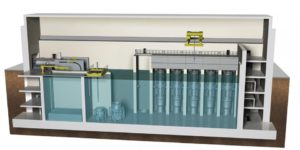 China National Nuclear Corporation (CNNC) announced plans to build a floating small modular reactor (SMR) in the island province of Hainan. Just last month China’s Ministry of Environment began its impact assessment of the ACP100 – the unit’s technical name – bringing the project into its next stage of development. China now joins the United States and Russia in the race for commercially viable SMR technology. SMR’s are the next evolutionary step of nuclear power: compact, affordable, quick to construct, emission-less, and in some cases transportable. SMRs provide flexibility to integrate with renewables and can generate highly resilient baseload power at cost-competitive prices. Their modular design facilitates mass production and enables units to be scaled up and down according to need. But why SMRs over existing nuclear tech? The biggest issues with conventional nuclear facilities are their sometimes multi-decade construction times and high capital expenditures – reaching an average of $11 billion per unit in 2018. Furthermore, large land area requirements and safety concerns preclude nuclear power stations from being located too close to urban centers – meaning that costly power lines must also be constructed to connect supply with demand. By contrast, SMR’s have a small footprint (the size of a barge or small house), enhanced safety, rapid build-times, and a unit cost between $800 million to $3 billion – making them ideal for remote areas suffering from low energy access. Forbes
China National Nuclear Corporation (CNNC) announced plans to build a floating small modular reactor (SMR) in the island province of Hainan. Just last month China’s Ministry of Environment began its impact assessment of the ACP100 – the unit’s technical name – bringing the project into its next stage of development. China now joins the United States and Russia in the race for commercially viable SMR technology. SMR’s are the next evolutionary step of nuclear power: compact, affordable, quick to construct, emission-less, and in some cases transportable. SMRs provide flexibility to integrate with renewables and can generate highly resilient baseload power at cost-competitive prices. Their modular design facilitates mass production and enables units to be scaled up and down according to need. But why SMRs over existing nuclear tech? The biggest issues with conventional nuclear facilities are their sometimes multi-decade construction times and high capital expenditures – reaching an average of $11 billion per unit in 2018. Furthermore, large land area requirements and safety concerns preclude nuclear power stations from being located too close to urban centers – meaning that costly power lines must also be constructed to connect supply with demand. By contrast, SMR’s have a small footprint (the size of a barge or small house), enhanced safety, rapid build-times, and a unit cost between $800 million to $3 billion – making them ideal for remote areas suffering from low energy access. Forbes
